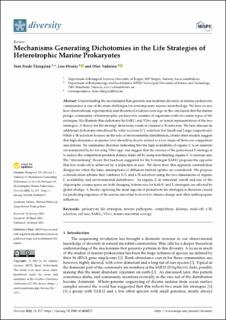| dc.contributor.author | Thingstad, T. Frede | |
| dc.contributor.author | Øvreås, Lise | |
| dc.contributor.author | Vadstein, Olav | |
| dc.date.accessioned | 2022-12-02T06:55:47Z | |
| dc.date.available | 2022-12-02T06:55:47Z | |
| dc.date.created | 2022-04-19T19:25:12Z | |
| dc.date.issued | 2022 | |
| dc.identifier.citation | Diversity. 2022, 14 (3), . | en_US |
| dc.identifier.issn | 1424-2818 | |
| dc.identifier.uri | https://hdl.handle.net/11250/3035469 | |
| dc.description.abstract | Understanding the mechanisms that generate and maintain diversity in marine prokaryotic communities is one of the main challenges for contemporary marine microbiology. We here review how observational, experimental, and theoretical evidence converge on the conclusion that the marine pelagic community of heterotrophic prokaryotes consists of organisms with two main types of life strategies. We illustrate this dichotomy by SAR11 and Vibrio spp. as typical representatives of the two strategies. A theory for life strategy dichotomy exists in classical r/K-selection. We here discuss an additional dichotomy introduced by what we term S/L-selection (for Small and Large, respectively). While r/K-selection focuses on the role of environmental disturbances, steady-state models suggest that high abundance at species level should be closely related to a low trade-off between competition and defense. We summarize literature indicating that the high availability of organic C is an essential environmental factor favoring Vibrio spp. and suggest that the essence of the generalized L-strategy is to reduce the competition-predator defense trade-off by using non-limiting organic C to increase size. The “streamlining” theory that has been suggested for the S-strategist SAR11 proposes the opposite: that low trade-off is achieved by a reduction in size. We show how this apparent contradiction disappears when the basic assumptions of diffusion-limited uptake are considered. We propose a classification scheme that combines S/L and r/K-selection using the two dimensions of organic C availability and environmental disturbance. As organic C in terrestrial runoff and size of the oligotrophic oceanic gyres are both changing, habitat size for both S- and L-strategists are affected by global change. A theory capturing the main aspects of prokaryote life strategies is therefore crucial for predicting responses of the marine microbial food web to climate change and other anthropogenic influences. | en_US |
| dc.language.iso | eng | en_US |
| dc.publisher | MDPI | en_US |
| dc.rights | Navngivelse 4.0 Internasjonal | * |
| dc.rights.uri | http://creativecommons.org/licenses/by/4.0/deed.no | * |
| dc.subject | prokaryote life strategies; marine pathogens; competition; defense; trade-off; r/K-selection; cell size; SAR11; Vibrio; marine microbial ecology | en_US |
| dc.title | Mechanisms Generating Dichotomies in the Life Strategies of Heterotrophic Marine Prokaryotes | en_US |
| dc.title.alternative | Mechanisms Generating Dichotomies in the Life Strategies of Heterotrophic Marine Prokaryotes | en_US |
| dc.type | Journal article | en_US |
| dc.type | Peer reviewed | en_US |
| dc.description.version | publishedVersion | en_US |
| dc.source.pagenumber | 0 | en_US |
| dc.source.volume | 14 | en_US |
| dc.source.journal | Diversity | en_US |
| dc.source.issue | 3 | en_US |
| dc.identifier.doi | 10.3390/d14030217 | |
| dc.identifier.cristin | 2017708 | |
| cristin.ispublished | true | |
| cristin.fulltext | original | |
| cristin.qualitycode | 1 | |

